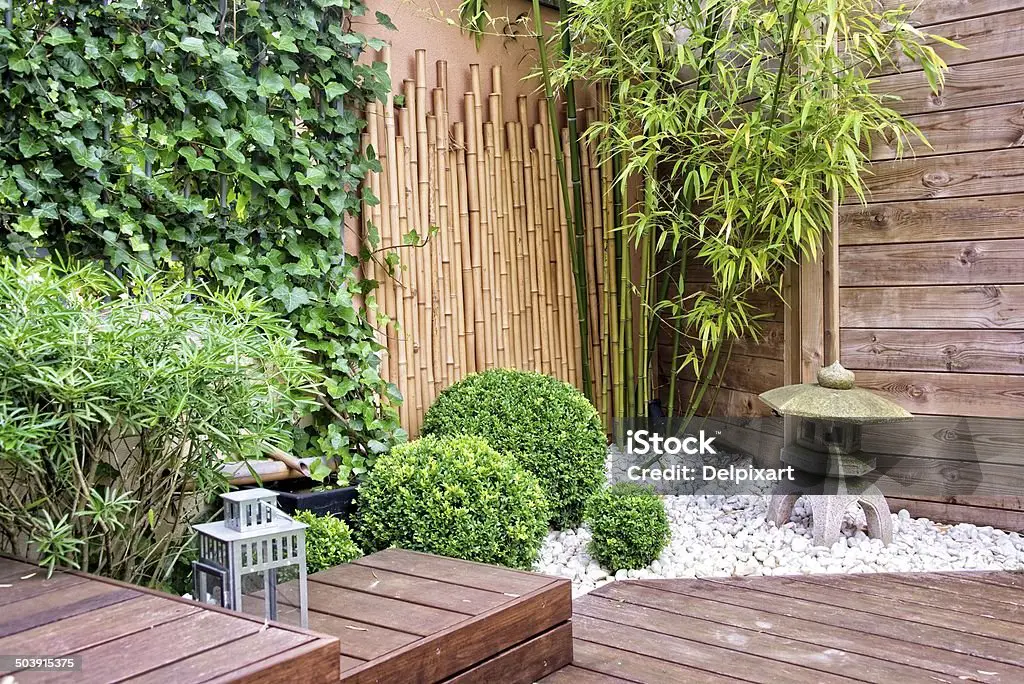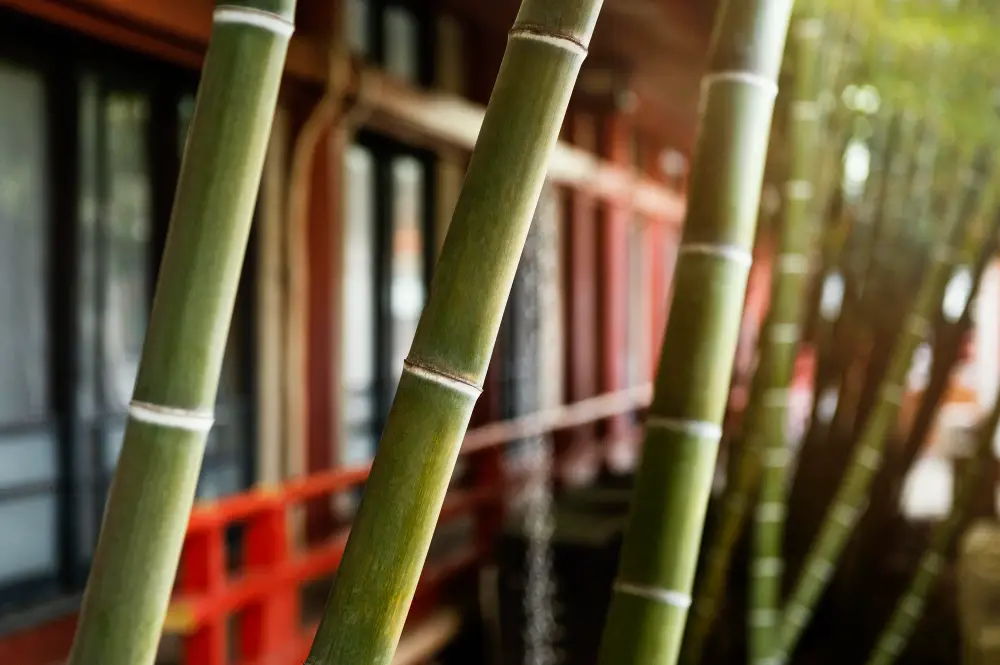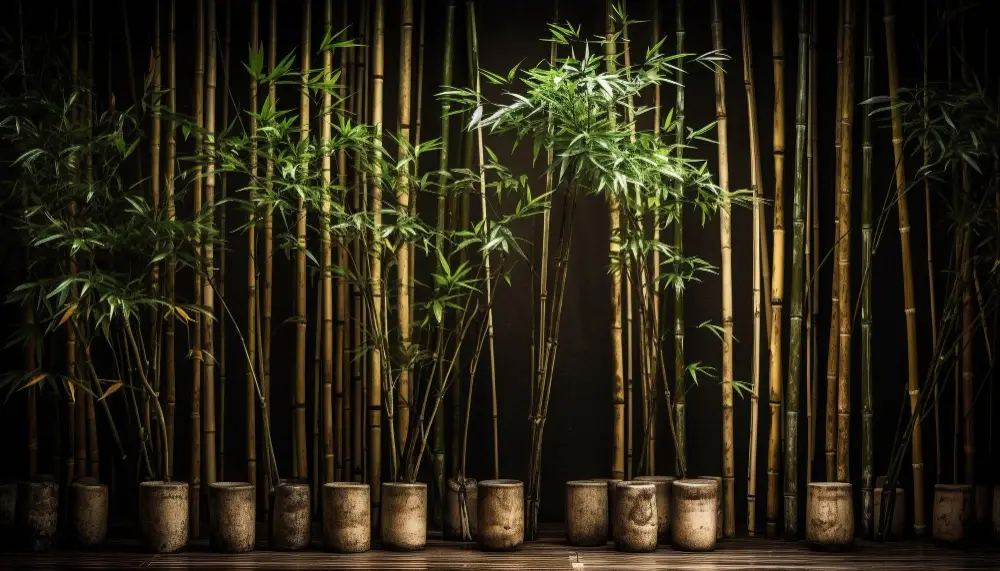Source: Freepik
Growing bamboo on your terrace offers a unique blend of benefits. From creating a private haven to adding a touch of eco-friendly style, bamboo brings more than just beauty to your outdoor space. But before you rush out and grab the first bamboo you see, let’s delve into the world of containerized bamboo and explore the secrets to its success.
This guide will be your comprehensive roadmap to growing bamboo on your terrace. We’ll cover everything you need to know, from choosing the perfect variety to ensuring its healthy growth and vibrant appearance. So, if you want to know how to grow bamboo on your terrace, get ready to unleash your inner green thumb and discover the magic of bamboo in your vertical jungle!
Table of Contents
Step-by-Step Guide to Growing Bamboo on Your Terrace
Lrt’s break down all the necessary steps:
Planning and Preparation
- Choose the right bamboo: Select a clumping variety suited to your container size and climate. Consider Fargesia Murielae, Fargesia Nitida, or Fargesia Robusta ‘Campbell’ for smaller spaces.
- Non-invasive varieties: Opt for clumping bamboos that grow in tight clusters. These won’t spread aggressively and are better suited for containers.
- Size and maturity: Consider the final size of the bamboo and ensure your container can accommodate it. Choose smaller, slower-growing varieties for limited space.
- Pick the perfect container: Opt for a sturdy, well-draining container like wood, galvanized steel, or thick plastic.
- Size: Use a large, sturdy container (min. 40cm deep, 50cm wide) with good drainage holes. Consider weight when choosing material (wooden containers offer insulation).
- Drainage: Crucial to prevent root rot. Add gravel or drainage mat at the bottom before filling with a well-draining, humus-rich potting mix.
- Prepare the soil: Create a well-draining mix with potting soil, compost, and perlite/vermiculite. Avoid garden soil, as it can compact and hinder drainage.
- Consider location: Sunlight needs vary depending on the bamboo variety. Most prefer 4-6 hours of direct sun, but some tolerate partial shade. Ensure protection from strong winds.

Planting and Care
- Plant your bamboo: Add gravel or drainage mat at the container bottom, fill with soil mix, and carefully plant your bamboo. Water thoroughly.
- Watering: Water regularly, especially during hot weather, aiming for moist but not soggy soil. Check moisture levels frequently, adjusting watering based on temperature and container size.
- Fertilizing: Use a balanced, slow-release fertilizer formulated for bamboo in early spring and mid-summer, following package instructions. Avoid overfertilizing.
- Mulching: Apply a layer of organic mulch around the base of the bamboo to retain moisture, suppress weeds, and regulate soil temperature.
- Trimming: Trim selectively to control size, remove dead canes, or encourage bushier growth. Research best practices for your specific bamboo variety.
Maintaining Your Bamboo Paradise
- Monitor for pests and diseases: Address any issues promptly with organic methods if possible. Consult a nursery if needed.
- Winter protection: In colder climates, insulate the container with bubble wrap or protect the roots with mulch. Move the container indoors if necessary.
- Enjoy the benefits: Relax and appreciate your thriving bamboo haven! Its privacy, beauty, and low maintenance will reward you for years to come.
Additional points
- Beware of spreading roots: Even clumping varieties can send roots beyond the container. Consider root barriers if concerned.
- Regular maintenance: Prune dead canes and manage new growth to maintain the desired size and shape.
- Local regulations: Check if there are any restrictions on growing bamboo in your area.
Best Bamboo for Treacces and Balconies
Here are some popular clumping bamboo varieties well-suited for growing on terraces:
Fargesia Murielae (Umbrella Bamboo)

- One of the most popular choices for containers due to its compact size (matures to 2-4 meters) and slow growth.
- Features dense, upright culms (stems) with arching green foliage, creating an umbrella-like canopy.
- Tolerates full sun to partial shade and adapts well to various climates.
Fargesia Nitida (Chinese Dwarf Bamboo)

- A miniature bamboo ideal for small terraces, reaching only 1-2 meters in height.
- Forms a dense clump with thin, green culms and delicate foliage.
- Prefers partial shade and well-drained soil.
Fargesia Robusta ‘Campbell’ (Campbell’s Bamboo)

- A slightly larger option, growing to 3-5 meters but maintaining a bushy, non-invasive form.
- Features thicker, golden culms and dark green leaves.
- Thrives in full sun to partial shade and tolerates colder temperatures.
Fargesia Draconachala ‘Rufa’ (Dragon Bamboo)
- Adds a touch of color with its reddish culms contrasting with bright green foliage.
- It reaches 1.5-2 meters in height, making it suitable for medium-sized containers.
- Prefers full sun to partial shade and enjoys moist but well-drained soil.
Bambusa Textilis (Silverstripe Bamboo)

- Offers a unique look with its green canes striped with silver bands.
- Grows to 3-5 meters and forms a dense, upright clump.
- Requires more sun than other varieties, preferably full sun with some afternoon shade.
What are the Best Conditions for Growing Bamboo?
While we mentioned some general aspects earlier, here’s a deeper dive into the best conditions for growing bamboo on your terrace:
Sun and Shade
- Most clumping bamboos prefer sunnier locations, ideally receiving at least 4-6 hours of direct sunlight daily. This promotes healthy growth and vibrant coloration.
- However, some varieties tolerate partial shade, like Fargesia Nitida and Fargesia Draconachala ‘Rufa’. These can be suitable for balconies with limited sun exposure.
- Avoid deep shade, as it can hinder growth and make the bamboo more susceptible to disease.
Temperature
Many clumping bamboos are cold-hardy, like Fargesia Murielae and Fargesia Robusta ‘Campbell’, tolerating temperatures down to -15°C (-5°F).
- Some varieties are even more cold-tolerant, like Fargesia Draconachala ‘Dragon Eyes’, surviving down to -25°C (-13°F).
- Research the specific temperature tolerance of your chosen variety to ensure it thrives in your climate. Winter protection like mulch or wrapping the container might be necessary in colder regions.
Watering and Drainage
- Bamboo requires consistent moisture but not waterlogging. Water regularly, especially during hot weather, aiming to keep the soil damp but not soggy.
- Excellent drainage is crucial. Choose a container with large drainage holes and use a well-draining potting mix. Adding gravel or drainage mats at the bottom helps prevent root rot.
- Container-grown bamboos dry out faster than ground-planted ones. Be mindful of this and adjust the watering frequency accordingly.
Soil and Fertilizer
- Use a high-quality, well-draining potting mix rich in organic matter. Look for mixes specifically designed for container plants or bamboo.
- Fertilize your bamboo in early spring and mid-summer with a slow-release fertilizer balanced for nitrogen. Avoid overfertilizing, which can damage the roots.
Wind and Shelter
- While some bamboos tolerate wind, strong gusts can damage their delicate foliage. Provide some protection from prevailing winds, especially for taller varieties.
- Consider positioning your container near a wall or planting wind-resistant shrubs nearby for additional shielding.

Source: Freepik
How to Choose the Best Fertilizer for Your Bamboo?
Choosing the right fertilizer for your bamboo is crucial for its healthy growth and vibrant appearance. Here’s a deeper dive:
Types of fertilizers
- Organic fertilizers: These release nutrients slowly over time, improving soil health and promoting balanced growth. Examples include compost, aged manure, or fish emulsion. They’re generally considered safer for the environment and less likely to cause chemical burns.
Read more about how to make compost in your garden.
- Inorganic fertilizers: These provide readily available nutrients in specific ratios, allowing for targeted correction of deficiencies. Choose formulations high in nitrogen (N) for promoting healthy leaves and balanced in phosphorus (P) and potassium (K) for root development and overall plant health.
Specific recommendations
- Organic fertilizers: Consider “Bamboo Food,” a commercially available organic fertilizer rich in essential nutrients specific to bamboo needs. Apply twice annually according to package instructions. Alternatively, compost tea or diluted fish emulsion can provide slow-release nutrients.
- Inorganic fertilizers: Opt for a balanced NPK fertilizer with a ratio of 5-3-3 or 7-3-3. Apply in early spring and mid-summer, following the dosage recommendations on the label. Be cautious not to overfertilize, as it can damage the roots.
Additional tips
- Soil testing: Before fertilizing, consider getting your soil tested to identify any specific nutrient deficiencies and tailor your fertilizer choice accordingly.
- Foliar feeding: During the growing season, you can supplement with a diluted foliar fertilizer spray directly on the leaves for faster nutrient uptake.
- Watering and timing: Always water your bamboo thoroughly before applying fertilizer to avoid root burn. Apply fertilizers during active growth periods (spring and summer) and avoid fertilizing before winter dormancy.
Important notes
- Container-grown bamboos require more frequent fertilization than ground-planted ones due to limited nutrient reserves in the container.
- Be mindful of your local regulations and environmental concerns when choosing fertilizers. Organic options are generally considered more eco-friendly.
- Always follow the dosage and application instructions on the fertilizer label to avoid harming your bamboo.
Remember, consulting a local nursery specializing in bamboo can provide valuable guidance on the best fertilizer type and application schedule for your specific variety and local conditions.
How to Deal With Pests on Your Bamboo?
Yes, bamboo can get pests, though they are generally less susceptible compared to other plants. However, the type and severity of pests can vary depending on several factors:
Bamboo variety: Some varieties are more resistant than others. Clumping bamboos tend to be less attractive to pests than running varieties.
Location: Climate, local pest populations, and surrounding plants can all influence pest pressure.
Growing conditions: Stress caused by inadequate watering, lack of nutrients, or improper drainage can make bamboo more vulnerable to pests.
Here are some common pests that can affect bamboo:
- Insects:
- Mites: Bamboo spider mites and Pacific bamboo mites can cause damage to leaves.
- Aphids, mealybugs, and scale: These sap-sucking insects can cause discoloration, wilting, and stunting.
- Bamboo powderpost beetles: These bore into the culms (stems) and can weaken the bamboo structure.
- Rodents: Gophers, squirrels, and rabbits can gnaw on young shoots and rhizomes.
While most pests won’t cause fatal damage, monitoring your bamboo and taking action if you see signs of infestation is important. Early intervention can prevent larger problems. Here are some things you can do:
- Monitor your bamboo regularly: Look for signs of damage, such as chewed leaves, discoloration, or webbing.
- Encourage beneficial insects: Ladybugs, lacewings, and predatory mites can help control pest populations naturally.
- Use organic methods first: Neem oil, insecticidal soap, and diatomaceous earth can be effective against some pests.
- Insecticides: As a last resort, consider using an insecticide specifically formulated for bamboo pests. Always follow the label instructions carefully.

Source: Freepik
Should You Trim Bamboo?
Whether or not you should trim your bamboo depends on several factors, including:
The type of bamboo: Running bamboo, known for its aggressive growth, usually benefits from regular trimming to control its spread and maintain its size. Clumping bamboos, which grow in tight clusters, often require less trimming but may still benefit from occasional pruning to remove dead or damaged canes.
The size and shape you desire: If you want to maintain a specific size or shape for your bamboo, trimming is necessary. Trimming can promote bushier growth or remove unwanted height.
Overall health and appearance: Look for dead, diseased, or damaged canes that need removal to improve the bamboo’s health and appearance. Trimming also encourages new, healthy growth.
The season: The optimal time for trimming can vary depending on your location and bamboo variety. Generally, late spring or early summer is recommended, allowing time for new growth to develop before winter.
Here are some specific situations where trimming your bamboo might be beneficial:
- Preventing your bamboo from outgrowing its space: Trimming regularly helps keep it contained and prevents it from encroaching on other plants or structures.
- Encouraging new growth: Removing older canes allows more sunlight and nutrients to reach newer shoots, promoting bushier and healthier growth.
- Improving the aesthetics: Trimming can help shape your bamboo into a desired form, like a hedge or screen.
- Removing dead or diseased canes: This prevents the spread of disease and keeps your bamboo healthy.
However, if your bamboo is:
- Happy and healthy: You may not need to trim it unless it’s causing specific problems.
- A slow-growing variety: Frequent trimming might hinder its natural growth potential.
- Recently planted: Allow it some time to establish itself before considering trimming.
Bamboo Companion Plants
Pairing bamboo with other plants can create a lush and visually appealing composition on your terrace. Here are some good options to consider, categorized by their function and visual appeal:
Complementary foliage
- Ferns: Their delicate fronds provide a textural contrast to the bamboo’s verticality. Opt for shade-tolerant varieties like Maidenhair fern or Japanese painted fern if your bamboo receives limited sun.

- Hostas: Their broad, colorful leaves add visual interest and ground cover. Choose shade-loving varieties like ‘Blue Angel’, or ‘Gold Standard‘ if your bamboo prefers partial shade.

- Ornamental grasses: These provide movement and texture, especially in windy conditions. Consider low-growing options like Blue fescue or Japanese blood grass if your bamboo is on the smaller side.

Colorful accents
- Bleeding heart: The bleeding heart flower is a shade-loving perennial that offers heart-shaped flowers in pink or white, adding a touch of romance.

- Begonias: Their vibrant blooms come in various colors and thrive in partial shade, creating a cheerful contrast to the bamboo’s green foliage.

- Impatiens: These shade-tolerant annuals boast colorful flowers that bloom throughout the summer, adding a burst of color to your container garden.

Ground covers
- Creeping Jenny: This fast-growing vine spills over the edges of the container, softening its look and suppressing weeds. Choose a shade-tolerant variety like ‘Variegata’ if your bamboo gets limited sun.

- Lamium: This shade-loving ground cover features attractive foliage in various colors and textures, adding visual interest and preventing soil erosion. Consider options like ‘Golden Glow’ or ‘Purple Heart’.

- Sedum: These low-growing succulents come in diverse shapes and colors, thriving in sunny locations and requiring minimal care. Opt for varieties like ‘Silver Blob’ or ‘Coral Reef’ for added texture and pops of color.

Consider your bamboo’s specific needs, like sun and water requirements, when choosing companion plants. Choose varieties with similar needs to ensure they all thrive in your terrace environment. With careful planning and plant selection, you can create a beautiful and harmonious bamboo container garden that flourishes for years to come.

